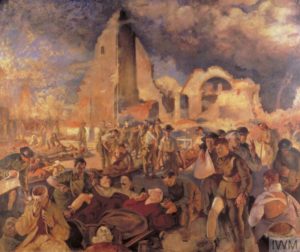Tuesday October 15th, 1918
Getting along fine. Walking quite free. Raining and cold. Sorry for the lads in the line. God Bless Them. Hope they are safe.
Advanced Dressing Station (ADS) in Maurois
Frank is clearly feeling much better and thinking of his comrades. Meanwhile, the battalion is re-organizing and training – presumably for imminent, future action.
Today the 2/3rd East Lancs Field Ambulance (2/3 ELFA) is on the move again. In support of the 66th Division and just behind the fighting troops, the unit moved to Serain on October 10th. From there they moved to Maretz and today will be in Maurois, presumably alongside the 9th Battalion.
In Maurois, ‘the unit took over the Advanced Dressing Station (situated in a large factory recently used by the Germans as a hospital) – from the 1st South African Field Ambulance.‘¹. As such, from tomorrow, the unit will become responsible for the evacuation of wounded from the forward area. To facilitate this the Bearer division, motor transport and horse-drawn ambulances will fall under its control.
Despite, or possibly because of, all this movement, the 66th Divisional Sick Station admitted 312 soldiers over the past seven days.¹
ADS in Action

As recalled by Travis Hampson MC in his memoir: ‘In theory the FA [Field Ambulance] bearers collect wounded from the Regimental Aid Post (RAP), to which place they have been brought by the Regimental stretcher bearers. …
In a scattered action, naturally the wounded will be all over the place, many will never get to the Regimental Aid Post (RAP), and have to be searched for and collected together for dressing or evacuation. The next step in the evacuation is the carriage of the wounded from the RAP or round about to the FA Advanced Dressing Station (ADS). The position of this is of course extremely variable, depending on the situation, but if possible it is a place on a road where our horse buses can be got to, and where the wounded can be attended to, that is, those who need further attention before their next move.
These ADS’s have to be as close as possible to avoid long carries by bearers, and are often within rifle range of the enemy.‘²
The painting shows an ADS in France in 1918. It was painted by Henry Tonks, FRCS (1868-1937) who was both a surgeon and an artist.* During the war he worked as a medical orderly with the Red Cross, a Lt with the RAMC and an official war artist. In 1918, he traveled through the battlefields with John Singer Sargent and later went to Archangel.³
Presumably its accessible location is why both the 9th and the 2/3 ELFA are in Maurois today.
9th Battalion War Diary – 15th October 1918 – Maurois
Training and reorganization.
References & Further Reading
¹ War Diary for October 15th, 1918, 2/3 East Lancashire Field Ambulance, National Archives.
² ‘1914 to 1919 A Medical Officer’s diary and narrative of the First World War‘ by Travis Hampson MC, ed by TP Davis, 1999-2001
* Art.IWM ART 1922, copyright Imperial War Museums
³ Henry Tonks on Wikipedia


